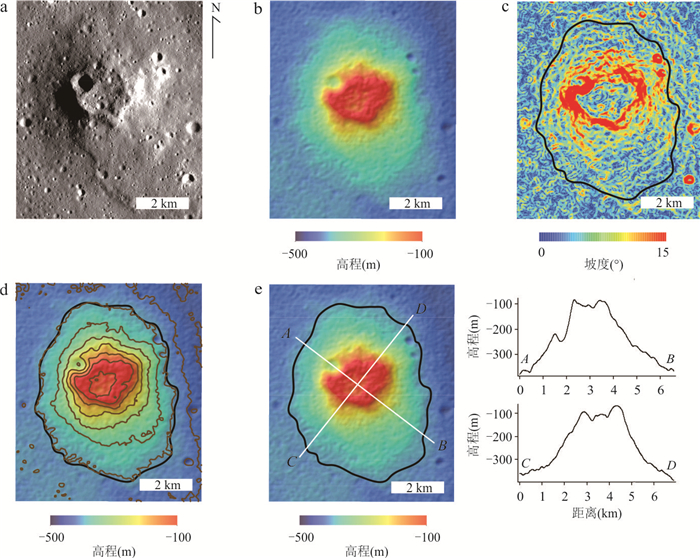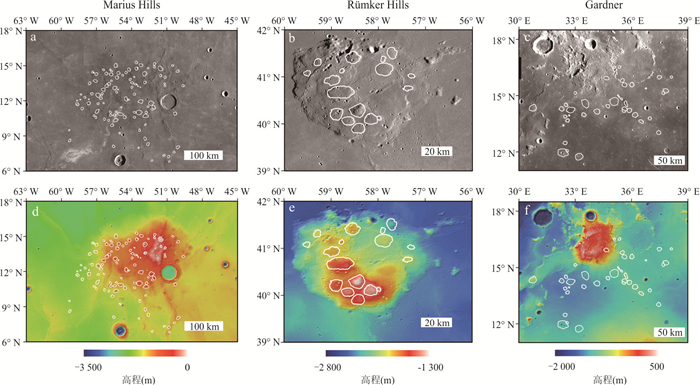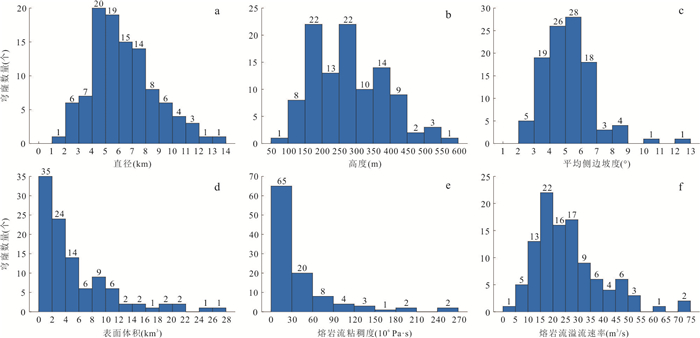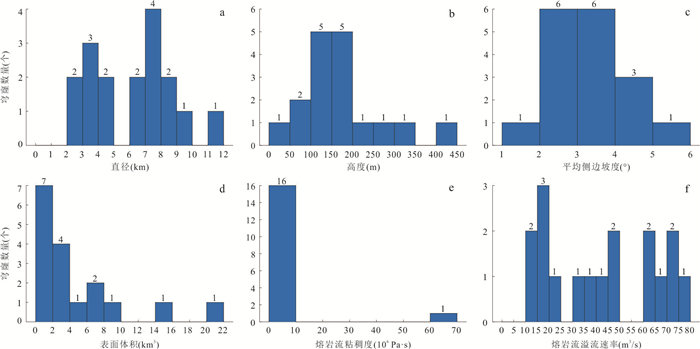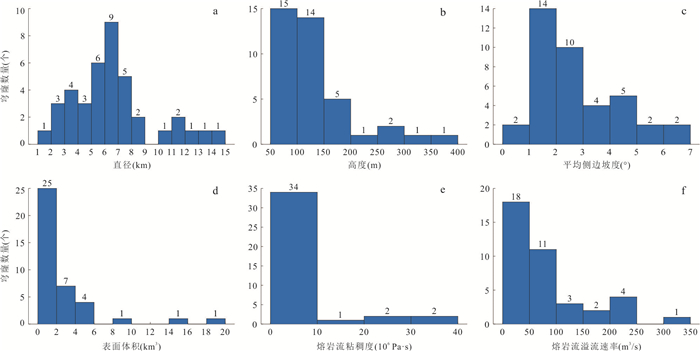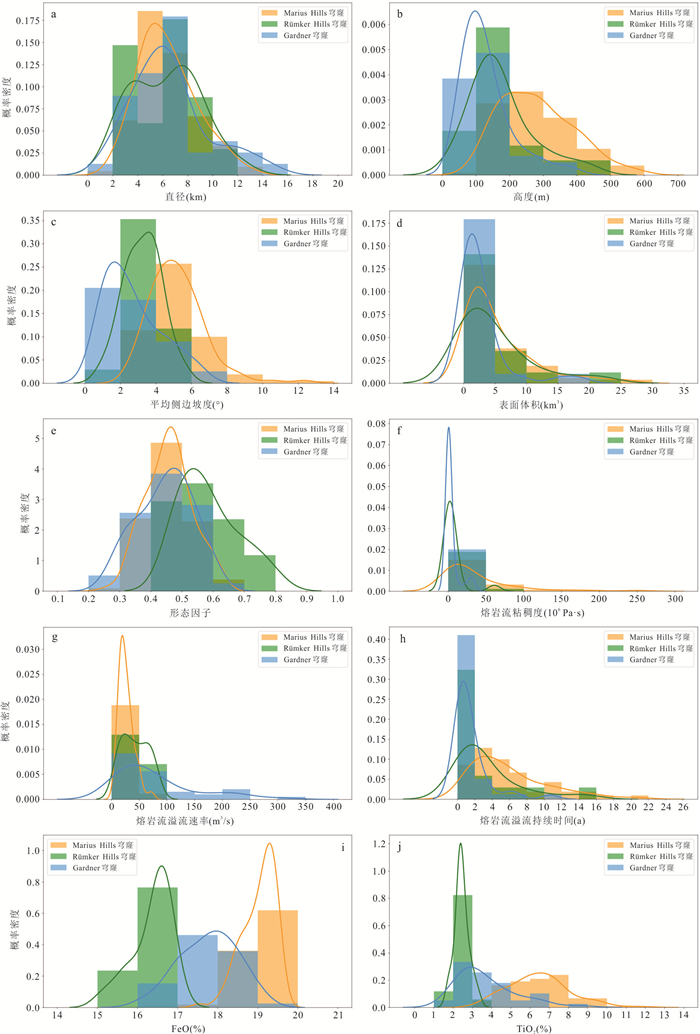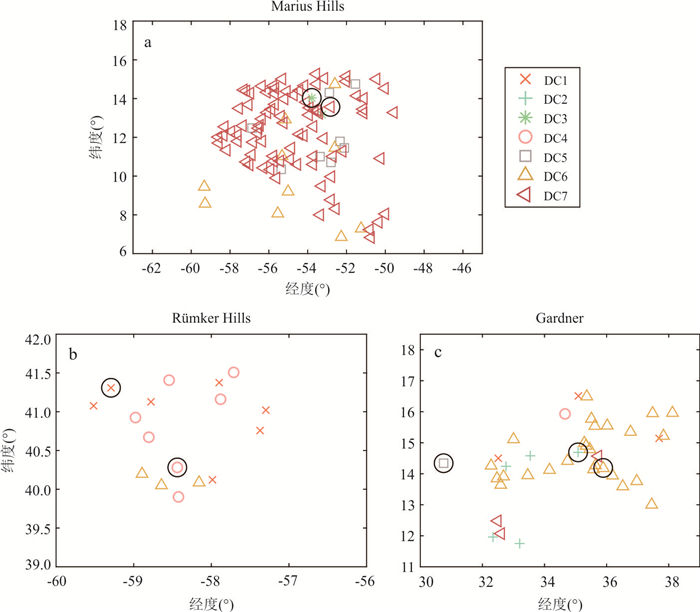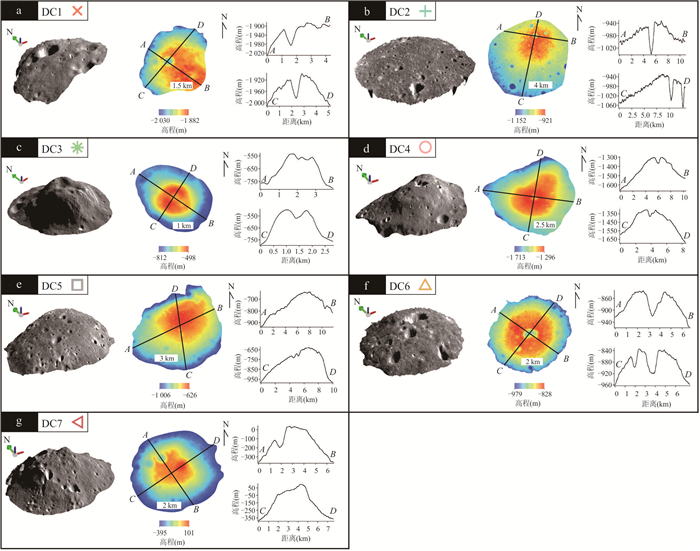Morphological Identification and Clustering Analysis of Domes in the Lunar Large Volcanic Complexes
-
摘要: 月球火山穹窿是了解月球火山活动的重要窗口.利用高分辨率多源遥感数据,对月球正面的3个火山复合体区(Marius Hills和Rümker Hills位于风暴洋克里普地体,Gardner在风暴洋克里普地体外)里发育的火山穹窿进行形貌和铁钛元素特征提取,利用这些特征参数进行层次聚类分析,并将所有穹窿划分为7个聚类(DC1~DC7);然后结合流变学、年代学和区域地质背景对3个火山复合体区的火山活动特征进行了综合分析.Marius Hills发育的火山穹窿数量多,高度和坡度较高,以中高钛为主,穹窿代表类型为DC7,岩浆活动时间跨度大(约2.6 Ga)、周期长,表明该区域存在多期次不同特征的火山活动.Rümker Hills发育的火山穹窿数量少,高度和坡度居中,以低钛为主,穹窿代表类型为DC1和DC4,活动时间相对集中(约0.8 Ga).Gardner及其周边区域发育的穹窿呈环状和带状分布,高度和坡度较低,以中低钛为主,岩浆活动时间持续约1.0 Ga,穹窿代表类型为DC6,该区域发生了多期次且复杂多样的火山活动.本研究揭示了月球正面火山复合体岩浆活动的复杂性,这种复杂性可能与岩浆源区及生热元素的不均匀分布情况有关.Abstract: Lunar volcanic domes are essential windows into the volcanic activities of the Moon. This study uses high-resolution multi-source remote sensing data to extract the morphological features and Fe-Ti contents of volcanic domes developed in the three large volcanic complexes (Marius Hills and Rümker Hills in the PKT region, and Gardner outside the PKT area) on the lunar nearside. Hierarchical clustering analysis is performed with these parameters and all domes are classified into seven dome clusters (DC1‒DC7). Comprehensive analyses of the rheology, chronology, and geological background of the three large volcanic complexes are carried out. Our results show that the Marius Hills developed a large number of volcanic domes with large height and slope, dominated by medium to high TiO2 contents, and the representative group of the domes is DC7. The geological age of the Marius Hills has a wide time span (~2.6 Ga), indicating a long-lasting volcanic activity in this region with multiple sources and phases. The volcanic domes developed in the Rümker Hills are small in number, moderate in height and slope, and dominated by low TiO2 contents. The representative groups of domes in this region are DC1 and DC4. Rümker Hills has a relatively concentrated geological time period (~0.8 Ga), but with multiple phases of volcanic activities. The domes developed in the Gardner and its surroundings are either radially or annularly distributed, with low height and slope, dominated by low to medium TiO2 contents, with magmatic activity lasting about 1.0 Ga. The representative group of the domes in the Gardner region is DC6, and multiple phases and complicated volcanic activities have occurred in this region. This study suggests the complexity of the magmatic activities of the lunar volcanic complexes, which may be related to different magma sources and the existence of heat-producing elements.
-
Key words:
- Moon /
- volcanic complexes /
- dome /
- feature extraction /
- clustering analysis /
- remote sensing
-
图 1 月球正面高程分布
图中白色圆圈为8个火山穹窿复合体,黑色虚线内为风暴洋克里普(Procellarum KREEP terrane,简称PKT)区域,红色箭头指示发育有多个火山穹窿的Marius Hills、Rümker Hills和Gardner火山穹窿复合体,据Huang et al.(2020)修改
Fig. 1. Elevation map of the lunar nearside
图 8 火山穹窿层次聚类结果
a. Marius Hills;b. Rümker Hills;c. Gardner.图a~c中黑色圆形标识为在每一类中选取的具有代表性的火山穹窿,将在图 9中作细节展示
Fig. 8. Hierarchical Clustering results of the volcanic domes
图 9 典型火山穹窿的三维渲染图、高程图、高程剖面
图a~g依次为层次聚类结果中DC1~DC7类别的典型火山穹窿(图 8黑色圆形标识),其中图c、g中的穹窿来自Marius Hills地区;图a、d中的穹窿来自Rümker Hills地区;图b、e、f中的穹窿来自Gardner地区.每个穹窿都选取了沿直线AB、CD方向具有代表性的高程剖面
Fig. 9. 3D-rendering images, elevation maps, and profiles of the representative volcanic domes
-
Arya, A. S., Rajasekhar, R. P., Sur, K., et al., 2018. Morphometric and Rheological Study of Lunar Domes of Marius Hills Volcanic Complex Region Using Chandrayaan-1 and Recent Datasets. Journal of Earth System Science, 127(5): 70. https://doi.org/10.1007/s12040-018-0971-y Baratoux, D., Pinet, P., Toplis, M. J., et al., 2009. Shape, Rheology and Emplacement Times of Small Martian Shield Volcanoes. Journal of Volcanology and Geothermal Research, 185(1-2): 47-68. https://doi.org/10.1016/j.jvolgeores.2009.05.003 Bohnenstiehl, D. R., Howell, J. K., White, S. M., et al., 2012. A Modified Basal Outlining Algorithm for Identifying Topographic Highs from Gridded Elevation Data, Part 1: Motivation and Methods. Computers & Geosciences, 49: 308-314. https://doi.org/10.1016/j.cageo.2012.04.023 Chen, Y. C., Huang, Q., Zhao, J. N., et al., 2021. Unsupervised Machine Learning on Domes in the Lunar Gardner Region: Implications for Dome Classification and Local Magmatic Activities on the Moon. Remote Sensing, 13(5): 845. https://doi.org/10.3390/rs13050845 Euillades, L. D., Grosse, P., Euillades, P. A., 2013. NETVOLC: An Algorithm for Automatic Delimitation of Volcano Edifice Boundaries Using DEMs. Computers & Geosciences, 56: 151-160. https://doi.org/10.1016/j.cageo.2013.03.011 Giguere, T. A., Taylor, G. J., Hawke, B. R., et al., 2000. The Titanium Contents of Lunar Mare Basalts. Meteoritics & Planetary Science, 35(1): 193-200. https://doi.org/10.1111/j.1945-5100.2000.tb01985.x Gillis, J. J., Jolliff, B. L., Elphic, R. C., 2003. A Revised Algorithm for Calculating TiO2 from Clementine UVVIS Data: A Synthesis of Rock, Soil, and Remotely Sensed TiO2 Concentrations. Journal of Geophysical Research: Planets, 108(E2): 5009. https://doi.org/10.1029/2001je001515 Grosse, P., van Wyk de Vries, B., Euillades, P. A., et al., 2012. Systematic Morphometric Characterization of Volcanic Edifices Using Digital Elevation Models. Geomorphology, 136(1): 114-131. https://doi.org/10.1016/j.geomorph.2011.06.001 Head, J. W., Gifford, A., 1980. Lunar Mare Domes: Classification and Modes of Origin. The Moon and the Planets, 22(2): 235-258. https://doi.org/10.1007/BF00898434 Heather, D. J., Dunkin, S. K., Wilson, L., 2003. Volcanism on the Marius Hills Plateau: Observational Analyses Using Clementine Multispectral Data. Journal of Geophysical Research (Planets), 108(E3): 5017. https://doi.org/10.1029/2002JE001938 Hiesinger, H., Gebhart, J., van der Bogert, C. H., et al., 2016. Stratigraphy of Low Shields and Mare Basalts of the Marius Hills Region, Moon. The 47th Lunar and Planetary Science Conference, Houston. Hiesinger, H., Jaumann, R., Neukum, G., et al., 2000. Ages of Mare Basalts on the Lunar Nearside. Journal of Geophysical Research: Planets, 105(E12): 29239-29275. https://doi.org/10.1029/2000je001244 Huang, Q., Zhao, J. N., Wang, X. M., et al., 2020. A Large Long-Lived Central-Vent Volcano in the Gardner Region: Implications for the Volcanic History of the Nearside of the Moon. Earth and Planetary Science Letters, 542: 116301. https://doi.org/10.1016/j.epsl.2020.116301 Lawrence, D. J., Feldman, W. C., Barraclough, B. L., et al., 1998. Global Elemental Maps of the Moon: The Lunar Prospector Gamma-Ray Spectrometer. Science, 281(5382): 1484-1489. https://doi.org/10.1126/science.281.5382.1484 Lawrence, D. J., Feldman, W. C., Elphic, R. C., et al., 2002. Iron Abundances on the Lunar Surface as Measured by the Lunar Prospector Gamma-Ray and Neutron Spectrometers. Journal of Geophysical Research (Planets), 107(E12): 5130. https://doi.org/10.1029/2001JE001530 Lawrence, S. J., Stopar, J. D., Hawke, B. R., et al., 2013. LRO Observations of Morphology and Surface Roughness of Volcanic Cones and Lobate Lava Flows in the Marius Hills. Journal of Geophysical Research: Planets, 118(4): 615-634. https://doi.org/10.1002/jgre.20060 Lena, R., Wöhler, C., Phillips, J., et al., 2013. Lunar Domes: Properties and Formation Processes. Springer & Praxis Publishing, Chichester. Li, Q. L., Zhou, Q., Liu, Y., et al., 2021. Two-Billion-Year-Old Volcanism on the Moon from Chang'E-5 Basalts. Nature, 600: 54-58. https://doi.org/10.1038/s41586-021-04100-2 Lin, Y. T., 2010. Key Issues of the Formation and Evolution of the Moon. Geochimica, 39(1): 1-10 (in Chinese with English abstract). Liu, J. J., Li, C. L., Wang, W. R., et al., 2019. Extraction of Lunar Domes from Chang'E-2 Data with New Method. Icarus, 321: 29-33. https://doi.org/10.1016/j.icarus.2018.10.030 Lucey, P. G., Blewett, D. T., Jolliff, B. L., 2000. Lunar Iron and Titanium Abundance Algorithms Based on Final Processing of Clementine Ultraviolet-Visible Images. Journal of Geophysical Research: Planets, 105(E8): 20297-20305. https://doi.org/10.1029/1999je001117 Morota, T., Haruyama, J., Ohtake, M., et al., 2011. Timing and Characteristics of the Latest Mare Eruption on the Moon. Earth and Planetary Science Letters, 302(3-4): 255-266. https://doi.org/10.1016/j.epsl.2010.12.028 Podobnikar, T., 2012. Detecting Mountain Peaks and Delineating Their Shapes Using Digital Elevation Models, Remote Sensing and Geographic Information Systems Using Autometric Methodological Procedures. Remote Sensing, 4(3): 784-809. https://doi.org/10.3390/rs4030784 Qiao, L., Chen, J., Ling, Z. C., 2021. Volcanic Landforms on the Moon. Acta Geologica Sinica, 95(9): 2678-2691 (in Chinese with English abstract). Qiao, L., Head, J. W., Wilson, L., et al., 2021. Mare Domes in Mare Tranquillitatis: Identification, Characterization, and Implications for Their Origin. Journal of Geophysical Research (Planets), 126(9): e06888. https://doi.org/10.1029/2021JE006888 Sato, H., Robinson, M. S., Lawrence, S. J., et al., 2017. Lunar Mare TiO2 Abundances Estimated from UV/Vis Reflectance. Icarus, 296: 216-238. https://doi.org/10.1016/j.icarus.2017.06.013 Spudis, P. D., McGovern, P. J., Kiefer, W. S., 2013. Large Shield Volcanoes on the Moon. Journal of Geophysical Research: Planets, 118(5): 1063-1081. https://doi.org/10.1002/jgre.20059 Tian, H. C., Wang, H., Chen, Y., et al., 2021. Non-KREEP Origin for Chang'E-5 Basalts in the Procellarum KREEP Terrane. Nature, 600: 59-63. https://doi.org/10.1038/s41586-021-04119-5 Weitz, C. M., Head, J. W. Ⅲ, 1999. Spectral Properties of the Marius Hills Volcanic Complex and Implications for the Formation of Lunar Domes and Cones. Journal of Geophysical Research: Planets, 104(E8): 18933-18956. https://doi.org/10.1029/1998je000630 Whitford-Stark, J. L., Head, J. W., 1977. The Procellarum Volcanic Complexes: Contrasting Styles of Volcanism. Lunar and Planetary Science Conference Proceedings, 3: 2705-2724. Wieczorek, M. A., Phillips, R. J., 2000. The "Procellarum KREEP Terrane": Implications for Mare Volcanism and Lunar Evolution. Journal of Geophysical Research: Planets, 105(E8): 20417-20430. https://doi.org/10.1029/1999je001092 Wilson, L., Head, J. W., 2003. Lunar Gruithuisen and Mairan Domes: Rheology and Mode of Emplacement. Journal of Geophysical Research (Planets), 108(E2): 5012. https://doi.org/10.1029/2002JE001909 Wöhler, C., Lena, R., 2009. Lunar Intrusive Domes: Morphometric Analysis and Laccolith Modelling. Icarus, 204(2): 381-398. https://doi.org/10.1016/j.icarus.2009.07.031 Wöhler, C., Lena, R., Lazzarotti, P., et al., 2006. A Combined Spectrophotometric and Morphometric Study of the Lunar Mare Dome Fields near Cauchy, Arago, Hortensius, and Milichius. Icarus, 183(2): 237-264. https://doi.org/10.1016/j.icarus.2006.03.003 Wöhler, C., Lena, R., Phillips, J., 2007. Formation of Lunar Mare Domes along Crustal Fractures: Rheologic Conditions, Dimensions of Feeder Dikes, and the Role of Magma Evolution. Icarus, 189(2): 279-307. https://doi.org/10.1016/j.icarus.2007.01.011 Wood, C. A., Higgins, W., Pau, K. C., et al., 2005. The Lamont-Gardner Megadome Alignment: A Lunar Volcano-Tectonic Structure? The 36th Annual Lunar and Planetary Science Conference, League City. Xu, Y. G., 2010. Mare Basalts and Lunar Evolution. Geochimica, 39(1): 50-62 (in Chinese with English abstract). Yang, W., Hu, S., Li, Q. L., et al., 2022. How Long Has Lunar Volcanism Lasted? Earth Science, 47(10): 3789-3791 (in Chinese). Zhang, F., Zhu, M. H., Bugiolacchi, R., et al., 2018. Diversity of Basaltic Lunar Volcanism Associated with Buried Impact Structures: Implications for Intrusive and Extrusive Events. Icarus, 307: 216-234. https://doi.org/10.1016/j.icarus.2017.10.039 Zhao, J. N., Xiao, L., Qiao, L., et al., 2017. The Mons Rümker Volcanic Complex of the Moon: A Candidate Landing Site for the Chang'E-5 Mission. Journal of Geophysical Research: Planets, 122(7): 1419-1442. https://doi.org/10.1002/2016je005247 林杨挺, 2010. 月球形成和演化的关键科学问题. 地球化学, 39(1): 1-10. https://www.cnki.com.cn/Article/CJFDTOTAL-DQHX201001004.htm 乔乐, 陈剑, 凌宗成, 2021. 月球火山作用的地貌学特征. 地质学报, 95(9): 2678-2691. https://www.cnki.com.cn/Article/CJFDTOTAL-DZXE202109005.htm 徐义刚, 2010. 月海玄武岩与月球演化. 地球化学, 39(1): 50-62. https://www.cnki.com.cn/Article/CJFDTOTAL-DQHX201001010.htm 杨蔚, 胡森, 李秋立, 等, 2022. 月球火山活动究竟能持续多久? 地球科学, 47(10): 3789-3791. doi: 10.3799/dqkx.2022.810 -









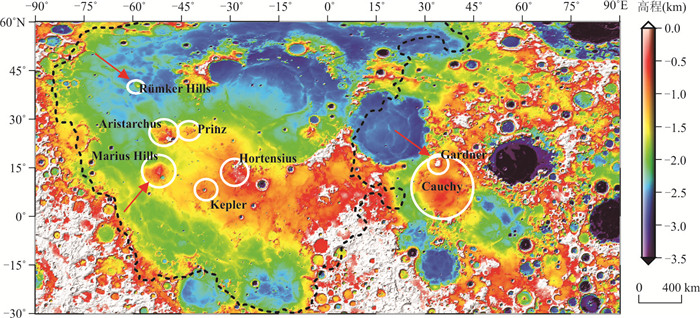
 下载:
下载:
